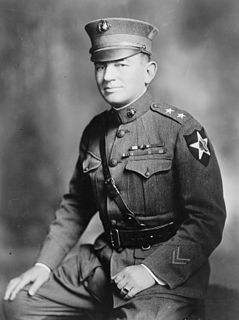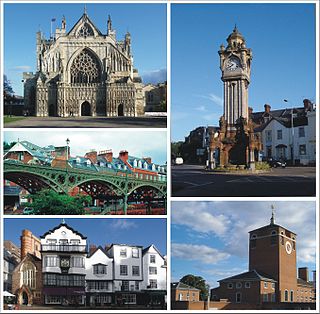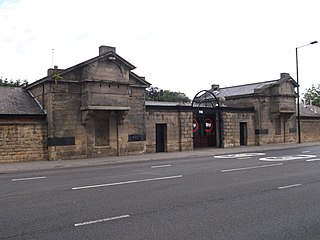
The Australian Army is the principal land warfare force of Australia, a part of the Australian Defence Force (ADF) along with the Royal Australian Navy and the Royal Australian Air Force. The Army is commanded by the Chief of Army (CA), who is subordinate to the Chief of the Defence Force (CDF) who commands the ADF. The CA is also directly responsible to the Minister for Defence, with the Department of Defence administering the ADF and the Army.
The Officers' Training Corps (OTC), more fully called the University Officers' Training Corps (UOTC), are military leadership training units operated by the British Army. Their focus is to develop the leadership abilities of their members whilst giving them an opportunity to take part in military life whilst at university. OTCs also organise non-military outdoor pursuits such as hill walking and mountaineering. UOTC units are not deployable units nor are their cadets classed as trained soldiers. The majority of members of the UOTC do not go on to serve in the regular or reserve forces.

The 1st Division, formerly known as the 1st Armoured Division and the 1st Division, is a division of the British Army.

John Archer Lejeune was a United States Marine Corps lieutenant general and the 13th Commandant of the Marine Corps. Lejeune served for nearly 40 years in the military, and commanded the U.S. Army's 2nd Division during World War I. After his retirement from the Marine Corps he became superintendent of the Virginia Military Institute.

Catterick Garrison is a major garrison and military town 3 miles (5 km) south of Richmond, North Yorkshire, England. It is the largest British Army garrison in the world, with a population of around 13,000 in 2017 and covering over 2,400 acres. Under plans announced by the Ministry of Defence (MoD) in November 2005, its population is expected to grow to over 25,000, making it the largest population centre in the local area.

The Intelligence Corps is a corps of the British Army. It is responsible for gathering, analysing and disseminating military intelligence and also for counter-intelligence and security. The Director of the Intelligence Corps is a brigadier.

The 1st Armoured Infantry Brigade was an infantry brigade of the British Army with a long history including service during both the First and the Second World Wars. It was based at Tidworth Camp. Previously, it has been designated 1st (Guards) Brigade, 1st Infantry Brigade, 1st Mechanised Brigade, and under the initial Army 2020 reforms assumed the title of 1st Armoured Infantry Brigade. Under the Future Soldier programme, the brigade merged with the 1st Artillery Brigade to form the 1st Deep Recce Strike Brigade Combat Team.

Colchester Garrison is a major garrison located in Colchester in the county of Essex, Eastern England. It has been an important military base since the Roman era. The first permanent military garrison in Colchester was established by Legio XX Valeria Victrix in AD 43 following the Roman conquest of Britain. Colchester was an important garrison town during the Napoleonic Wars and throughout the Victorian era. During the First World War several battalions of Kitchener's Army were trained there. Now, 2nd Battalion and 3rd Battalion of The Parachute Regiment are based there. Today there are new barracks, which, in replacing the Victorian buildings, have made available building land slightly nearer the town centre.

The 3rd Infantry Brigade was a Regular Army infantry brigade of the British Army, part of the 1st Infantry Division. Originally formed in 1809, during the Peninsular War, the brigade had a long history, seeing action in the Second Anglo-Afghan War, and during both the First and the Second World Wars.
The 43rd Infantry Brigade was a brigade of the British Army during the First and Second World Wars, and later, as 43 (Wessex) Brigade, a regional headquarters from 1985 to 2014.

Bulford Camp is a military camp on Salisbury Plain in Wiltshire, England. Established in 1897, the site continues in use as a large British Army base. The camp is close to the village of Bulford and is about 2+1⁄4 miles (3.6 km) northeast of the town of Amesbury. The camp forms part of the Tidworth, Netheravon and Bulford (TidNBul) Garrison.

Exeter is a city in Devon, South West England. It is situated on the River Exe, approximately 36 mi (58 km) northeast of Plymouth and 65 mi (105 km) southwest of Bristol.
Bickleigh Barracks is a military installation at Bickleigh, South Hams which is currently used by 42 Commando.

Imphal Barracks is a military installation located in Fulford, York, England.

Fenham Barracks is a military installation in Barrack Road, Newcastle upon Tyne.

Wyvern Barracks is a military installation on Topsham Road in Exeter.

Cowley Barracks was a military installation in Cowley, Oxfordshire, England.

Inglis Barracks was a military installation in Mill Hill, London, NW7. It was also referred to as Mill Hill Barracks. The site has been redeveloped and now contains a variety of modern housing.

Hightown Barracks is a military installation in Wrexham, Wales.

Tidworth Camp is a military installation at Tidworth in Wiltshire, England. It forms part of the Tidworth, Netheravon and Bulford (TidNBul) Garrison.


















